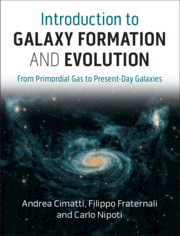28 results
Appendix C - Astronomical Compendium
-
- Book:
- Introduction to Galaxy Formation and Evolution
- Published online:
- 09 February 2024
- Print publication:
- 17 October 2019, pp 502-519
-
- Chapter
- Export citation
2 - The Cosmological Framework
-
- Book:
- Introduction to Galaxy Formation and Evolution
- Published online:
- 09 February 2024
- Print publication:
- 17 October 2019, pp 13-27
-
- Chapter
- Export citation
1 - Introduction
-
- Book:
- Introduction to Galaxy Formation and Evolution
- Published online:
- 09 February 2024
- Print publication:
- 17 October 2019, pp 1-12
-
- Chapter
- Export citation
References
-
- Book:
- Introduction to Galaxy Formation and Evolution
- Published online:
- 09 February 2024
- Print publication:
- 17 October 2019, pp 533-554
-
- Chapter
- Export citation
8 - Main Ingredients of Galaxy Formation Theory
-
- Book:
- Introduction to Galaxy Formation and Evolution
- Published online:
- 09 February 2024
- Print publication:
- 17 October 2019, pp 225-309
-
- Chapter
- Export citation
9 - From Recombination to Reionisation
-
- Book:
- Introduction to Galaxy Formation and Evolution
- Published online:
- 09 February 2024
- Print publication:
- 17 October 2019, pp 310-349
-
- Chapter
- Export citation
Appendix D - Physics Compendium
-
- Book:
- Introduction to Galaxy Formation and Evolution
- Published online:
- 09 February 2024
- Print publication:
- 17 October 2019, pp 520-532
-
- Chapter
- Export citation
7 - Formation, Evolution and Properties of Dark Matter Halos
-
- Book:
- Introduction to Galaxy Formation and Evolution
- Published online:
- 09 February 2024
- Print publication:
- 17 October 2019, pp 195-224
-
- Chapter
- Export citation
3 - Present-Day Galaxies as a Benchmark for Evolutionary Studies
-
- Book:
- Introduction to Galaxy Formation and Evolution
- Published online:
- 09 February 2024
- Print publication:
- 17 October 2019, pp 28-53
-
- Chapter
- Export citation
5 - Present-Day Early-Type Galaxies
-
- Book:
- Introduction to Galaxy Formation and Evolution
- Published online:
- 09 February 2024
- Print publication:
- 17 October 2019, pp 125-162
-
- Chapter
- Export citation
4 - Present-Day Star-Forming Galaxies
-
- Book:
- Introduction to Galaxy Formation and Evolution
- Published online:
- 09 February 2024
- Print publication:
- 17 October 2019, pp 54-124
-
- Chapter
- Export citation
Index
-
- Book:
- Introduction to Galaxy Formation and Evolution
- Published online:
- 09 February 2024
- Print publication:
- 17 October 2019, pp 555-572
-
- Chapter
- Export citation
Appendix B - Constants and Units
-
- Book:
- Introduction to Galaxy Formation and Evolution
- Published online:
- 09 February 2024
- Print publication:
- 17 October 2019, pp 500-501
-
- Chapter
- Export citation
Brief Contents
-
- Book:
- Introduction to Galaxy Formation and Evolution
- Published online:
- 09 February 2024
- Print publication:
- 17 October 2019, pp v-vi
-
- Chapter
- Export citation
10 - Theory of Galaxy Formation
-
- Book:
- Introduction to Galaxy Formation and Evolution
- Published online:
- 09 February 2024
- Print publication:
- 17 October 2019, pp 350-421
-
- Chapter
- Export citation
Preface
-
- Book:
- Introduction to Galaxy Formation and Evolution
- Published online:
- 09 February 2024
- Print publication:
- 17 October 2019, pp xi-xiv
-
- Chapter
- Export citation
11 - Observing Galaxy Evolution
-
- Book:
- Introduction to Galaxy Formation and Evolution
- Published online:
- 09 February 2024
- Print publication:
- 17 October 2019, pp 422-496
-
- Chapter
- Export citation
6 - The Environment of Present-Day Galaxies
-
- Book:
- Introduction to Galaxy Formation and Evolution
- Published online:
- 09 February 2024
- Print publication:
- 17 October 2019, pp 163-194
-
- Chapter
- Export citation

Introduction to Galaxy Formation and Evolution
- From Primordial Gas to Present-Day Galaxies
-
- Published online:
- 09 February 2024
- Print publication:
- 17 October 2019
-
- Textbook
- Export citation
Appendix A - Acronyms
-
- Book:
- Introduction to Galaxy Formation and Evolution
- Published online:
- 09 February 2024
- Print publication:
- 17 October 2019, pp 497-499
-
- Chapter
- Export citation



